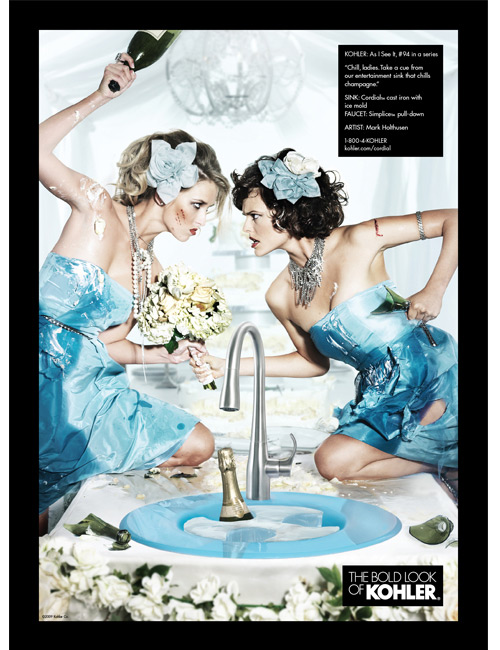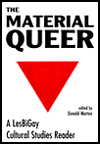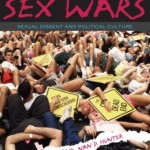It is the first week of the semester. In anticipation of my blog experiment in queering theory, we are reading several essays on queer blogging. While I have spent some time thinking about feminist blogging and have read a few articles about the (specifically) feminist possibilities of blogging for teaching/thinking/activism, I have not given that much attention to all of this in relation to queer/queering. For class today, we are discussing: Jill Dolan’s “Blogging on Queer Connections in the Arts and the Five Lesbian Brothers” (2005), Rahul Mitra’s and Radhika Gajjala’s “Queer Blogging in Indian Digital Diaspora: A Dialogic Encounter” (2008), and, if we have time, Julie Rak’s “The Digital Queer: Weblogs and Internet Identity” (2005). Here are some notes/thoughts about the readings:
Dolan. “Blogging on Queer Connections…”
In this article, which was written in 2005, Dolan discusses her experiences creating and writing in her feminist/queer/arts blog, The Feminist Spectator. The article is divided into three parts. First, Dolan offers some reflections on why she started her blog. Second, she provides, with only a few minor revisions, an entry from her blog on a performance in New York City by the Five Lesbian Brothers (here is the original entry from her blog). Third and finally, she offers some concluding thoughts (responses and reflections) on her blog entry and on blogging in general.
Initially I chose this article for us to read for a couple of reasons. First, Dolan offers some brief reflections on why blogging is a useful way to write and think which can be helpful as we try to understand how and why we will use the blog in the course. And second, she provides us with an example of blog writing that doesn’t fit the popular image of blog writing as confessional and purely personal (okay, perhaps we should interrogate what we mean by “personal” a bit more…how do we think about personal/”person”/body in relation to Mitra/Gajjala?).
Here are the reasons Dolan gives for why she started her blog:
1. Immediate critical (thinking) writing: A blog allows her to write in a timely fashion (as opposed to waiting 6 months or much more for an academic article or book to be published). And it allows her to write about performances that don’t usually get much attention. The idea of immediate critical writing is something that I also like about the blog. I really appreciate the fact that I can read an article (like this one) and immediately post my critical reactions to it on my blog.
A note of caution: The critical aspect of this process is crucial. Effective blog writing, for Dolan and for me/my course, goes beyond immediately posting every reaction to an idea or article. Effective blog writing requires critical reflection and the filtering and shaping of your reactions into a coherent and focused response.
In her concluding remarks, Dolan cautions against the dangers of immediate writing in her own blog. She writes:
I’ve found, in my very maiden adventures in blogging, that its immediacy lends it to an aura of risk. That is, rather than running my ideas through an intermediary like an editor, I offer them here with much less outside manipulation and consideration. The freedom of such a venue in which to write appeals to me; at the same time, I worry that I’ve been intemperate, already, in my writing here (505).
I agree with this caution. In previous entries, like here, I have talked about the dangers of immediacy, especially for students who are all fired up at 2 AM after reading a particularly problematic article for class. Here was the tentative conclusion that I came to in that entry:
The trick, I think, is to find a way to balance the benefits of immediate access (to expressing ideas, to connecting with others) with the necessity of posting thoughtful, responsible and accountable entries.
Perhaps one way to create this balance is to find ways to remember that blog writing is always for an audience…an audience that we are (whether we recognize it or not) accountable to and responsible for. I briefly talk about blog audiences here.
2. Freedom. Dolan wants to start her blog so that she can write as much as she wants. In her past experiences writing more immediate reviews of non-mainstream performances for small papers/dailies, she was limited to a very short word count. This prevented her from going beyond the “slash-and-burn, 200-word consumer reporting that too often characterizes arts coverage” (August 25, 2005). Because she wants to “stage a more deliberate, extended, generous kind of conversation about things I see at the theater, at the movies, or on television” (August 25, 2005), she wants to be able to write much longer entries.
I like her point here, but I wonder: Does limiting the number of words necessarily lead to a less thought out entry? Is it possible to engage “deeply” and critically with a topic in 200 words or less? On this trouble blog, I have experimented with this possibility (see here). Does it work? I am not sure, but there is something helpful about learning to communicate an idea/concept succinctly.
3. An outside/outsider space. Drawing upon her training and experiences, Dolan wants to write a blog that deals with gender and race and that is written from a queer perspective. Her blog is aimed at those outside of mainstream media. A blog allows her to stay on the outside, to not be (as) concerned with any “mainstream readership” and what they might think or understand about her queer musing on gender/race/identity.
Questions: Is a blog an outsider space? A queer space? If so, how? Is it always outside? Do you see any ways that a blog can/does perpetuate dominate ideologies or participate in oppressive systems?
4. A specific (friendly) audience. Consider what Dolan writes about her ideal audience:
I was looking for a forum to read friends, colleagues, and other sympathetic readers interested in a discussion about the meanings of the arts in this moment in U.S. culture. I think, in fact, I was looking for a place to preach to the converted through a more in-depth discourse about the interrelationship between the arts, identity, and culture (492).
Questions: Is this the type of audience we want to create for our blog? What are the advantages and disadvantages of writing for sympathetic readers? Dolan links the idea of a friendly audience with “preaching to the converted.” Are these two always connected? Is it possible to write for a friendly (that is, not hostile but respectful) audience that is still critical of your ideas and comments? Should the blog be a safe space or something else?
Later in her opening comments, Dolan indicates that her blog is meant to be widely accessible and aimed at “any reader/spectator/practitioner” or “citizen/scholar/artist” who is committed to the arts (493). I really like this term, citizen/scholar/artist, and her description of what she wants to do in her blog.
What do you want to do in our blog? Who do you want to read it? What audiences are you writing for/to/with?
Mitra/Gajjala. “Queer Blogging in Indian Digital Diasporas”
This essay is a “dialogic encounter” between two scholars (one a grad student, the other an associate professor at Bowling Green State) who do research on and participate in “queering in the Indian digital diaspora” (400). The tone is very different from Dolan and so is the focus. Whereas Dolan looks at her own (individual) experiences of creating and writing in a blog about performance and art, Mitra and Gajjala weave their own performances of blogging (by interjecting entries/comments into their essay) together with other bloggers’ entries and comments and with theorizing about queer Indian identity/blogging, power, and blogs as spaces of situated practice.
Situated Practices: Dolan is focused (almost exclusively) on writing about her own blogging as the (somewhat situated) practice of an individual critical thinker/spectator/graduate program director in the U.S. who writes about peformance and writes to others who value/engage in exploring arts and their meanings in U.S. culture. In her concluding remarks, she does offer a few cautionary words, but her overall tone reflects hope and excitement about the possibilities that blogging opens up for citizen/scholar/artists like her. Mitra and Gjjala are focused on providing a space for thinking about/reflecting on both queer blogging and “the negotiation of online queer Identity” (402). Their intent is not to celebrate the blog as a liberating space for oppressed populations to express themselves, but to examine “how queer/GLBT presences are manifested in blog spaces” (402). And they want to present/perform their own researching and writing of their article as the situated practice of queer bloggers/researchers who are (re)negotiating institutional power in relation to dichotomies of public vs. private, offline vs. online and person (as identity/Queer) vs. practice (non-normative sexual practices).
Personal and the Person: Dolan is interested in distancing her own version of blogging, what she calls “ruminations” and “think pieces” on arts and culture, from the personal (that is, confessional and self-revelatory) online journal writing that she imagines dominates much of the blog writing currently online. Mitra and Gajjala are interested in paying careful attention to how queer performativity as public gets separated from queer sexual practices as private. They are wary of the validation of the Person (as a Queer identity/Subject) over practices (of that queer person) and the promotion of the web as queer because it allows disembodied performances where no one knows who you are or what you do (401). They write:
In this article, we post this question implicitly while further examining the implications of the private and public separations that lead to the separating of sexual practice from queer practice so that particular queered speech and performativity are placed in the public space and expected to stand in for queer formations while specific situated queer practice is shifted to the invisible private space still not to be revealed for fear of consequence (411).
In considering this question, they want to attend to the specific ways that persons (particularly queer Indian bloggers) negotiate power online and offline. They devote the second half of their article to a discussion of three different ways that the dichotomy (public/private; Person/practice; online/offline) gets constructed and reinforced: 1. offline marginalization–can they be “out” and visible as queer? acceptance as Queer as long as queer acts are invisible (414-415), 2. online queer representation–issues of access to technology, to language, to proper queer behavior (415-417), 3. Being anonymous–confession and highly individualized construction of self and readership online (417-419).
Blogging and the Individual: This brings us to the individual and to Julie Rak’s article, “The Digital Queer.” In addition to giving a helpful overview of the history of blogging, Rak provides a detailed discussion of the rhetoric of queer blogging (this is something that Mitra and Gajjala take up explictly at the end of their article). Her main argument: blogging = some form of liberalism which = the Individual (their value and rights) + freedom of expression (172). In this equation, bloggers are individuals who are able, through technology, to freely express themselves and communicate to a wide range of others. They can do so anonymously (173), and while deliberately and carefully negotiating the public and private (173-174). Their blog posts are intended to honestly and accurately represent who they are; the blog allows them to be “real” (174-175). Their blog posts also enable them to connect with other, like-minded bloggers.
Rak sees two problems with this liberal ideology for queer blogging/bloggers. First, in representing themselves as a “real” individual who deliberately negotiates the web, bloggers are reinforcing their own (blog/queer) identity as essential and fixed. This identity gets further reified through the process of categorization and the classifying of specific blogs as “queer.” Rak writes:
The act of classification is a social act in the blogger community that works to create recognizable subjects who do not shift. Therefore, queer blogging does not feature the kind of subjectivity described in queer theory or in cyberculture studies as these areas have been influenced by postmodernist ideas about identity (177).
Second, the reification of Queer (as an identity, as a category for blogs) flattens out the differences between those who identify as queer and engage in queer practices. And it focuses (almost exclusively) on the practices of one version of queer experience–living in the U.S., American, English-speaking, located in large urban area, left-wing or liberal in political beliefs. For Rak, it seems, queer blogging is a privileged activity (179-180, also cited in Mitra/Gajjala, 420). This particular queer experience also seems to be conservative in terms of sexual identity, sexual practice and writing style. None of the blogs that Rak read experimented with representation in a “postmodern” way (what does she exactly mean by this?) (179).
Rak concludes her essay by discussing how the technical process of categorizing/classifying blogs through keywords contributes to the lack of differences among/between queer bloggers.
Questions: What are the politics of keywords and tag clouds? Are they useful or problematic or both? How could we use tag clouds to organize our blog in ways that don’t overemphasize similarities at the expense of differences?
How can blogger/bloggers experiment with the representation of themselves in a “postmodern” and/or queer way? What might a “queer” subject (not just in terms of content but in terms of subject formation/representation) look like?



